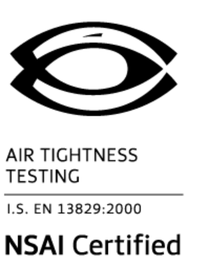What is an Air tightness Test
An Air Tightness test is a recognised method used to measure the total air lost through leaks in the building fabric. As stated in the Part L TGD it is a requirement to carry out an air leakage test on new builds to demonstrate compliance with Building Regulations.
An air tightness test must be carried out by an NSAI Registered Tester. The BERcerts.ie team are all NSAI Registered Testers.
Other than meeting compliance, the aim of an Air tightness test is to reduce energy losses in the building. A lot of energy can be lost through poor detailing at junctions and where services pass through the envelope. BERcerts.ie provide expert advice to both builders and homeowners, giving guidance and direction to areas of unwanted leakage and help reduce or eliminate completely.
At BERcerts.ie we advise carrying out two tests during the project to make sure you are on track. The best time to carry out the first test is during the first fix stage of the building when the initial airtightness layers are installed to determine any air leakages occurring. This allows builders to locate possible air leakage points before final finishes are installed. This prevents the situation where air leakage is detected behind one or more finished areas, requiring them to be removed to fix the problem and then redone, costing time and money for all involved.
A final test is then carried out once the dwelling is fully complete. As a result, builders and homeowners should achieve compliance with the Building regulations and also experience substantial savings in heating costs. The results can then be used as part of the BER calculations to improve the BER rating.
BERcerts.ie specialises in Energy ratings for both Domestic and Commercial Properties, Energy Audits, Land registry maps, Compliance to Part L (Energy) and part F (ventilation) building regulations, new regulation sound tests and also, Air pressure tests.
An air tightness test must be carried out by an NSAI Registered Tester. The BERcerts.ie team are all NSAI Registered Testers.
Other than meeting compliance, the aim of an Air tightness test is to reduce energy losses in the building. A lot of energy can be lost through poor detailing at junctions and where services pass through the envelope. BERcerts.ie provide expert advice to both builders and homeowners, giving guidance and direction to areas of unwanted leakage and help reduce or eliminate completely.
At BERcerts.ie we advise carrying out two tests during the project to make sure you are on track. The best time to carry out the first test is during the first fix stage of the building when the initial airtightness layers are installed to determine any air leakages occurring. This allows builders to locate possible air leakage points before final finishes are installed. This prevents the situation where air leakage is detected behind one or more finished areas, requiring them to be removed to fix the problem and then redone, costing time and money for all involved.
A final test is then carried out once the dwelling is fully complete. As a result, builders and homeowners should achieve compliance with the Building regulations and also experience substantial savings in heating costs. The results can then be used as part of the BER calculations to improve the BER rating.
BERcerts.ie specialises in Energy ratings for both Domestic and Commercial Properties, Energy Audits, Land registry maps, Compliance to Part L (Energy) and part F (ventilation) building regulations, new regulation sound tests and also, Air pressure tests.
What is involved in an Air tightness Test?
During a test, all vents and flues will be sealed within the property. Toilets, sinks, gullies and traps will also have water in them to prevent air flow through them. Once everything is sealed all internal doors are left open and a large fan is then installed into the primary entrance of the dwelling along with a special frame that is sealed around the opening before the test commences.
During the test a device called a Manometer is connected to the fan to collect results that will be put into software to complete the air tightness test. During the running of the fan it can also be checked to see if there are any areas where there is air leakage/ heat loss.
All tests undertaken are done in accordance to (I.S. EN ISO 9972:2015) and with NSAI specifications. The results within the air tightness report will contain the results for both negative pressure and positive pressure to a minimum of 50 Pascals pressure difference as well as the air permeability rate.
During the test a device called a Manometer is connected to the fan to collect results that will be put into software to complete the air tightness test. During the running of the fan it can also be checked to see if there are any areas where there is air leakage/ heat loss.
All tests undertaken are done in accordance to (I.S. EN ISO 9972:2015) and with NSAI specifications. The results within the air tightness report will contain the results for both negative pressure and positive pressure to a minimum of 50 Pascals pressure difference as well as the air permeability rate.

